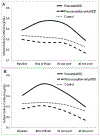Prenatal Major Depressive Disorder, Placenta Glucocorticoid and Serotonergic Signaling, and Infant Cortisol Response
- PMID: 27763986
- PMCID: PMC6541396
- DOI: 10.1097/PSY.0000000000000410
Prenatal Major Depressive Disorder, Placenta Glucocorticoid and Serotonergic Signaling, and Infant Cortisol Response
Abstract
Objectives: Extending prior studies of prenatal adversity and depressive symptoms, we tested associations between maternal prenatal major depressive disorder (MDD) and infant cortisol regulation. Based on prior findings by our group, we also tested placenta glucocorticoid (HSD11B2 methylation) and serotonin (SLC6A4 gene expression) signaling as moderators of links between prenatal MDD and infant cortisol.
Methods: Participants were 153 mother-infant pairs from a low-income, diverse sample (M [SD] age = 26 [6] years). Repeated structured diagnostic interviews were used to identify mothers with (a) prenatal MDD, (b) preconception-only MDD, and (c) controls. Placenta samples were assayed for HSD11B2 methylation and SLC6A4 gene expression. Infant salivary cortisol response to a neurobehavioral examination was assessed at 1 month.
Results: Daughters of prenatal MDD mothers had 51% higher baseline (ratio = 1.51; 95% confidence interval [CI] = 1.01-2.27; p = .045) and 64% higher stress responsive cortisol (ratio = 1.64; 95% CI = 1.05-2.56; p = .03) than daughters of controls and 75% higher stress-responsive cortisol (ratio = 1.75; 95% CI = 1.04-2.94; p = .04) than daughters of preconception-only MDD mothers. HSD11B2 methylation moderated links between prenatal MDD and baseline cortisol (p = .02), with 1% methylation decreases associated with 9% increased baseline cortisol in infants of prenatal MDD mothers (ratio = 1.09; 95% CI = 1.01-1.16). SLC6A4 expression moderated links between prenatal MDD and cortisol response among boys alone (p = .007), with 10-fold increases in expression associated with threefold increases in stress-responsive cortisol (ratio = 2.87; 95% CI = 1.39-5.93) in sons of control mothers.
Conclusions: Results highlight specificity of associations between prenatal versus preconception MDD and cortisol regulation and the importance and complexity of placenta glucocorticoid and serotonergic pathways underlying the intergenerational transmission of risk from maternal adversity.
Figures


Similar articles
-
Maternal stress, placental 11β-hydroxysteroid dehydrogenase type 2, and infant HPA axis development in humans: Psychosocial and physiological pathways.Placenta. 2021 Jan 15;104:179-187. doi: 10.1016/j.placenta.2020.12.008. Epub 2020 Dec 24. Placenta. 2021. PMID: 33360746 Free PMC article.
-
Placental epigenetic signatures of maternal distress in glucocorticoid-related genes and newborn outcomes: A study of Spanish primiparous women.Eur Neuropsychopharmacol. 2025 Jan;90:36-47. doi: 10.1016/j.euroneuro.2024.10.001. Epub 2024 Nov 6. Eur Neuropsychopharmacol. 2025. PMID: 39504602
-
Patterning in placental 11-B hydroxysteroid dehydrogenase methylation according to prenatal socioeconomic adversity.PLoS One. 2013 Sep 5;8(9):e74691. doi: 10.1371/journal.pone.0074691. eCollection 2013. PLoS One. 2013. PMID: 24040322 Free PMC article.
-
Maternal depressive symptoms during pregnancy, placental expression of genes regulating glucocorticoid and serotonin function and infant regulatory behaviors.Psychol Med. 2015 Nov;45(15):3217-26. doi: 10.1017/S003329171500121X. Epub 2015 Jun 22. Psychol Med. 2015. PMID: 26096463
-
The effect of gestational period on the association between maternal prenatal salivary cortisol and birth weight: A systematic review and meta-analysis.Psychoneuroendocrinology. 2018 Aug;94:49-62. doi: 10.1016/j.psyneuen.2018.04.023. Epub 2018 Apr 24. Psychoneuroendocrinology. 2018. PMID: 29754005
Cited by
-
Maternal Distress during Pregnancy and the Postpartum Period: Underlying Mechanisms and Child's Developmental Outcomes-A Narrative Review.Int J Mol Sci. 2022 Nov 11;23(22):13932. doi: 10.3390/ijms232213932. Int J Mol Sci. 2022. PMID: 36430406 Free PMC article. Review.
-
Placental DNA methylation marks are associated with maternal depressive symptoms during early pregnancy.Neurobiol Stress. 2021 Jul 31;15:100374. doi: 10.1016/j.ynstr.2021.100374. eCollection 2021 Nov. Neurobiol Stress. 2021. PMID: 34401410 Free PMC article.
-
Biological Embedding of Early-Life Adversity and a Scoping Review of the Evidence for Intergenerational Epigenetic Transmission of Stress and Trauma in Humans.Genes (Basel). 2023 Aug 17;14(8):1639. doi: 10.3390/genes14081639. Genes (Basel). 2023. PMID: 37628690 Free PMC article.
-
A systematic review of childhood maltreatment and DNA methylation: candidate gene and epigenome-wide approaches.Transl Psychiatry. 2021 Feb 19;11(1):134. doi: 10.1038/s41398-021-01207-y. Transl Psychiatry. 2021. PMID: 33608499 Free PMC article.
-
Maternal stress and placental function, a study using questionnaires and biomarkers at birth.PLoS One. 2018 Nov 15;13(11):e0207184. doi: 10.1371/journal.pone.0207184. eCollection 2018. PLoS One. 2018. PMID: 30439989 Free PMC article.
References
-
- Gavin NI, Gaynes BN, Lohr KN, Meltzer-Brody S, Gartlehner G, Swinson T. Perinatal depression: a systematic review of prevalence and incidence. Obstet Gynecol. 2005;106:1071–83. - PubMed
-
- Marcus SM, Flynn HA, Blow FC, Barry KL. Depressive symptoms among pregnant women screened in obstetrics settings. J Womens Health (Larchmt). 2003;12:373–80. - PubMed
-
- Le Strat Y, Dubertret C, Le Foll B. Prevalence and correlates of major depressive episode in pregnant and postpartum women in the United States. J Affect Disord. 2011;135:128–38. - PubMed
-
- Grigoriadis S, VonderPorten EH, Mamisashvili L, Tomlinson G, Dennis CL, Koren G, Steiner M, Mousmanis P, Cheung A, Radford K, Martinovic J, Ross LE. The impact of maternal depression during pregnancy on perinatal outcomes: a systematic review and meta-analysis. J Clin Psychiatry. 2013;74:e321–41. - PubMed
Publication types
MeSH terms
Substances
Grants and funding
LinkOut - more resources
Full Text Sources
Other Literature Sources
Medical

